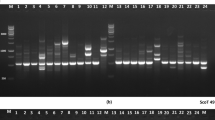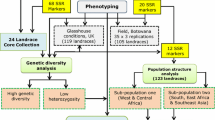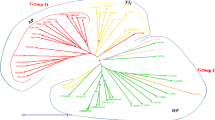Abstract
Brassica oleracea var. capitata L. is characterized by a high level of intraspecific heterogeneity due to some biological features that cause difficulties for breeding creating genetically homogenous forms and maintaining their genetic purity. Microsatellites (SSRs) are highly polymorphic markers of plant genomes and represent one of the most effective tools for assessing genetic polymorphism. Among microsatellites, EST-SSRs are the most interesting, because they are directly linked to the expressed sequences and for that reason are widely used for the analysis of genetic diversity and population structure. In this work, we studied the effectiveness of the use of transferable EST-SSR markers for analyzing both white cabbage diversity and genotyping of pure lines. As a result, 15 microsatellite loci were characterized for their information content, allelic frequencies, and heterogeneity levels. The effective multiallelic markers (Bo20TR, BoDCTD4, BoPC34, BoPLD1, BoCalc and BoPC15) with high information content (PIC > 0.7) that could be successfully used for the analysis of inter- and intravarietal polymorphism in Brassica oleracea var. capitata were identified. It has been shown that intervarietal polymorphism expressed as the allelic diversity of the EST-SSR loci greatly facilitates varietal identification and typing of individual plants for breeding purposes. Based on the SSR-evaluation and subsequent clustering, the genetic structure of the breeding collection was identified, which showed that most experimental forms, in spite of their different origins, have a common ancestral genetic basis. The identified donors of rare alleles could potentially be a source of valuable genetic segregation for further B. oleracea breeding improvement.
Similar content being viewed by others
References
Belaj, A., Satovich, Z., Ismaili, H., Panajoti, D., Rallo, L., and Trujillo, I., RAPD genetic diversity of Albanian olive germplasm and its relationships with other Mediterranian countries, Euphytica, 2003, vol. 130, pp. 387–395. doi 10.1023/A:1023042014081
Bhargava, A. and Fuentes, F.F., Mutational dynamics of microsatellites, Mol. Biotechnol., 2010, vol. 44, no. 3, pp. 250–266. doi 10.1007/s12033-009-9230-4
Cho, Y.G., Ishii, T., Temnykh, S., and Chen, X., Diversity of microsatellites derived from genomic libraries and GenBank sequences in rice (Oryza sativa L.), Theor. Appl. Genet., 2000, vol. 100, pp. 713–722. doi 10.1007/s001220051343
Eujay, I., Sorrells, M.E., Baum, M., Wolters, P., and Powell, W., Isolation of EST-derived microsatellite markers for genotyping the A and B genomes of wheat, Theor. Appl. Genet., 2002, vol. 104, pp. 399–407. doi 10.1007/s001220100738
Fang, Zh., Liu, Y., Lou, P., and Liu, G., Current trends in cabbage breeding, J. New Seeds, 2005, vol. 6, no. 2, pp. 3–75. doi 10.1300/J153v06n02_05
Kapil, A., Rai, P.K., and Shanker, A., ChloroSSRdb: A repository of perfect and imperfect chloroplastic simple sequence repeats (cpSSRs) of green plants, Database, 2014. doi 10.1093/database/bau107
Kashi, Y. and King, D.G., Simple sequence repeats as advantageous mutators in evolution, Trends Genet., 2006, vol. 22, pp. 253–259. doi 10.1016/j.tig.2006.03.00
Katti, M.V., Ranjekar, P.K., and Gupta, V.S., Differential distribution of simple sequence repeats in eukaryotic genome sequences, Mol. Biol. Evol., 2001, vol. 18, pp. 1161–1167. doi 10.1093/oxfordjournals.molbev.a003903
Liu, L., Liu, G., and Gong, Y., Evaluation of genetic purity of F1 hybrid seeds in cabbage with RAPD, ISSR, SRAP, and SSR markers, Hortscience, 2007, vol. 42, no. 3, pp. 724–727. http://hortsci.ashspublications.org/content/42/3/724.full.
Louarn, S., Torp, A.M., Holme, I.B., Andersen, S.B., and Jensen, B.D., Database derived microsatellite markers (SSRs) for cultivar differentiation in Brassica oleracea L., Genet. Resour. Crop. Evol., 2007, vol. 54, pp. 1717–1725. doi 10.1007/s10722-006-9181-6
Morgante, M., Hanafey, M., and Powell, W., Microsatellites are preferentially associated with nonrepetitive DNA in plant genomes, Nat. Genet., 2002, vol. 30, pp. 194–200. doi 10.1038/ng822
Peakall, R. and Smouse, P.E., GenAlEx 6.5: Genetic analysis in Excel. Population genetic software for teaching and research-an update, Bioinformatics, 2012, vol. 28, pp. 2537–2539.
Pritchard, M., Wen, W., and Falush, D., Documentation for Structure Software: Version 2.3. Department of Human Genetic, Department of Statistics, University of Chicago USA, 2009. http://pritchardlab.stanford.edu/home.html.
Reif, J.C., Warburton, M.L., Xia, X.C., Hoisington, D.A., Crossa, J., Taba, S., Muminovic, J., Bohn, M., Frisch, M., and Melchinger, A.E., Grouping of accessions of Mexican races of maize revisited with SSR markers, Theor. Appl. Genet., 2006, vol. 113, pp. 177–185. doi 10.1007/s00122-006-0283-5
Senan, S., Kizhakayil, D., Sasicumar, B., and Sheeja, Th., Methods for development of microsatellite markers: An overview, Not. Sci. Biol., 2014, vol. 6, no. 1, pp. 1–13. http://notulaebiologicae.ro/index.php/nsb/article/viewFile/9199/7883.
Tonguc, M. and Griffiths, Ph.D., Genetic relationships of Brassica vegetables determined using database derived simple sequence repeats, Euphytica, 2004, vol. 137, pp. 193–201. doi 10.1023/B:EUPH.0000041577.84388.43
Ye, Sh., Wang, Y., Huang, D., Li, J., Gong, Y., Xu, L., and Liu, L., Genetic purity testing of F1 hybrid seed with molecular markers in cabbage (Brassica oleracea var. capitata), Sci. Hortic., 2013, vol. 155, pp. 92–96. doi 10.1016/j.scienta. 2013.03.016
Zhang, L., Yuan, D., Yu, Sh., Li, Zh., Cao, Y., Miao, Zh., Qian, H., and Tang, K., Preference of simple sequence repeats in coding and non-coding regions of Arabidopsis thaliana, Bioinformatics, 2004, vol. 20, no. 7, pp. 1081–1086. doi 10.1093/bioinformatics/bth043
Author information
Authors and Affiliations
Corresponding author
Additional information
Original Russian Text © M.N. Shapturenko, T.V. Pechkovskaya, S.I. Vakula, A.V. Jakimovich, Yu.M. Zabara, L.V. Khotyleva, 2016, published in Vavilovskii Zhurnal Genetiki i Selektsii, 2016, Vol. 20, No. 1, pp. 51–56.
Rights and permissions
About this article
Cite this article
Shapturenko, M.N., Pechkovskaya, T.V., Vakula, S.I. et al. Informative EST-SSR markers for genotyping and intraspecific differentiation of Brassica oleracea var. capitata L.. Russ J Genet Appl Res 7, 14–20 (2017). https://doi.org/10.1134/S2079059717010129
Received:
Accepted:
Published:
Issue Date:
DOI: https://doi.org/10.1134/S2079059717010129




